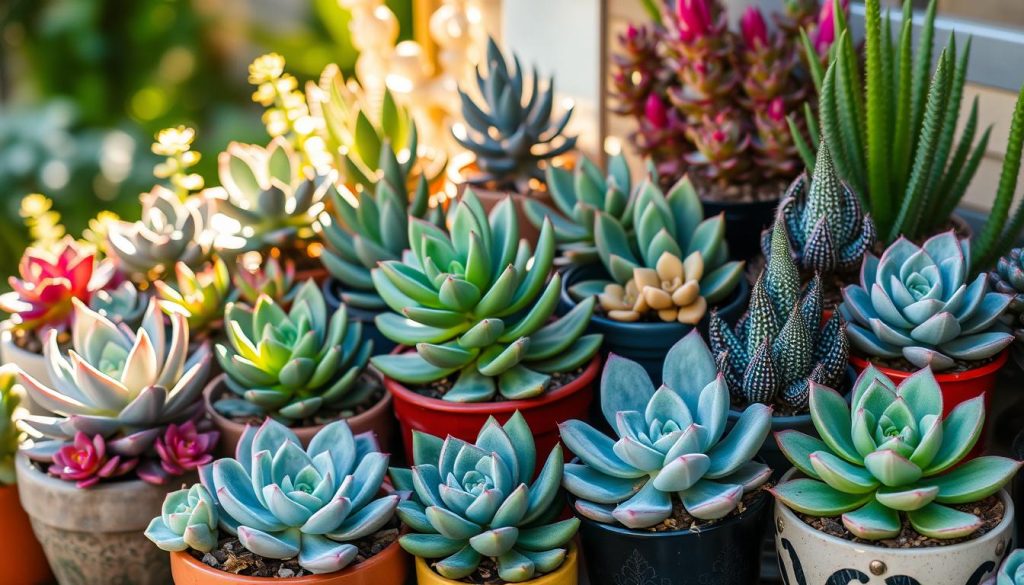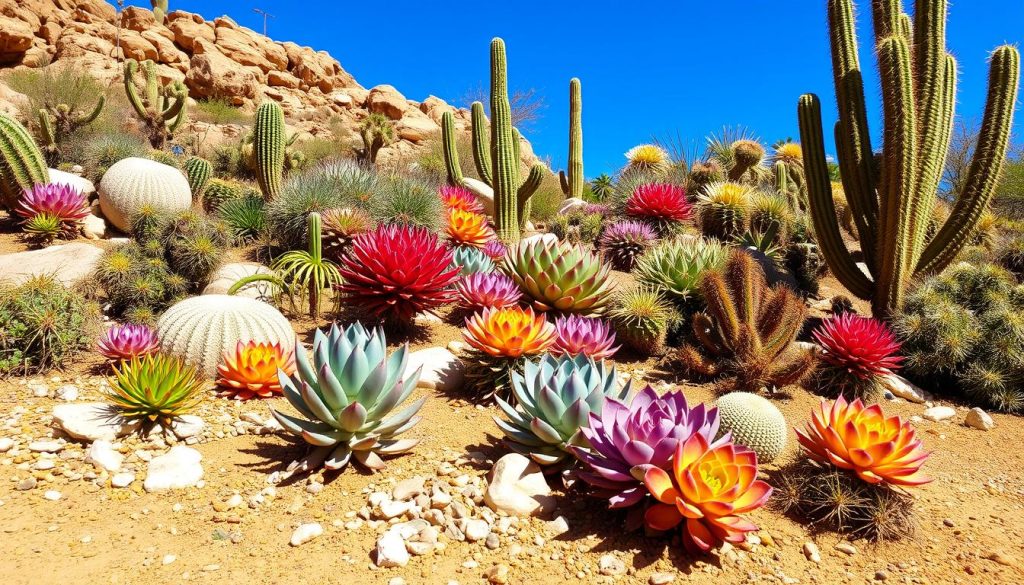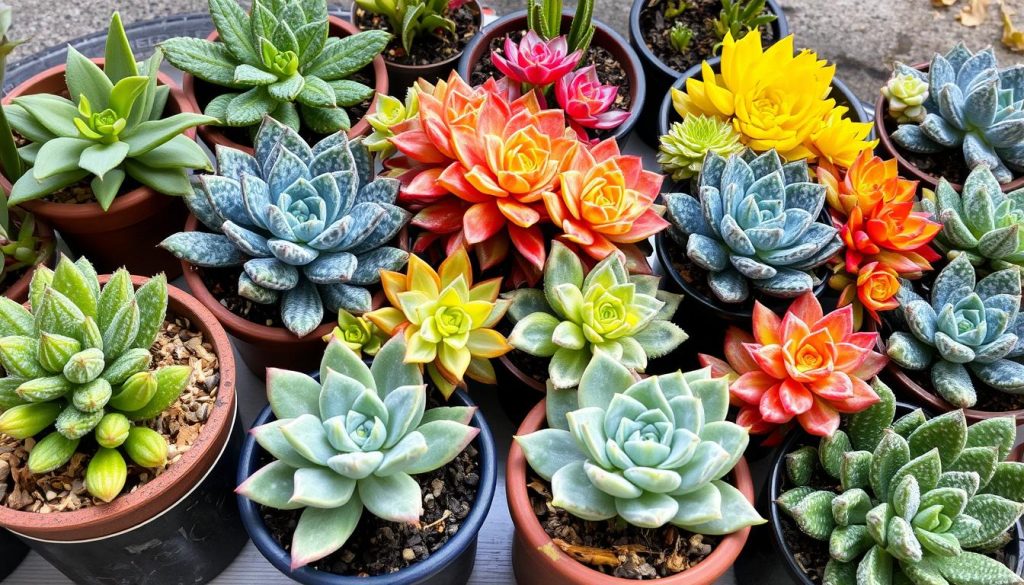Succulents are a favorite among indoor gardeners because they’re tough and easy to care for. These plants have thick leaves and roots that help them survive with little water. This guide is perfect for anyone wanting to grow beautiful succulents at home, whether you’re new to gardening or have lots of experience.

Key Takeaways
- Succulents are hardy, low-maintenance indoor plants that thrive in dry conditions.
- Succulents store water in their leaves and roots, making them well-suited for homes with infrequent watering.
- Proper container selection and well-draining soil are essential for the optimal growth of succulents.
- Succulents require bright, indirect sunlight and can be placed in various locations within your home.
- Propagation and seasonal care are important aspects of maintaining a healthy succulent collection.
Understanding What Makes Succulents Unique
Succulents are fascinating plants that can live in dry places. They have special ways to save water and grow well in dry areas. Let’s see what makes them special and why they’re loved for home gardens.
Defining Succulent Plants
Succulents store water in their leaves, stems, and roots. This helps them survive in places with little rain. They can hold up to 95% water, depending on the season and type.
Natural Adaptations and Features
Succulents have cool features to live in dry places. Their thick leaves and stems help keep water in. Some even have special parts to let sunlight in while they’re underground.
Cacti, a type of succulent, can grow and shrink to save water. They do this based on the weather and sunlight.
Popular Varieties for Home Growing
There are many succulent types for indoor and outdoor gardens. You can find everything from Hens and Chicks to Echeveria and Jade Plants. They come in all shapes, sizes, and colors.
Whether you like the patterns of sedums or the shapes of agave, there’s a succulent for you. They fit any home or garden perfectly.
Succulents are becoming very popular in homes. They need little care and come in many shapes, colors, and sizes. Their unique features and looks make them a hit worldwide.
Essential Growing Conditions for Indoor Succulents
Creating the perfect environment for your indoor succulents is key to their lush, healthy growth. These resilient plants thrive in specific conditions that mimic their natural desert habitat. To ensure your succulents flourish indoors, pay close attention to their lighting, soil, and watering needs.
Succulents need plenty of sunlight. They generally require about 6 hours of bright, indirect sunlight each day. Positioning them near a sunny window is ideal, as direct sunlight can scorch delicate leaves. Rotate your succulents regularly to ensure even exposure.
- Succulents need at least 6 hours of sunlight daily
- Indirect, bright light is best – avoid direct sun exposure
- Rotate plants regularly for even light distribution
Well-draining soil is also crucial for indoor succulents. A potting mix formulated specifically for cacti and succulents, or a blend of equal parts sand, perlite, and regular potting soil, will ensure proper drainage and prevent root rot. When repotting, select containers with ample drainage holes to allow excess water to escape.
Finally, be mindful of your watering schedule. Succulents prefer the “soak and dry” method, where you thoroughly water the soil until it drains out the bottom, then allow it to dry out completely before watering again. Overwatering is a common mistake that can quickly lead to the demise of these resilient plants.
- Well-draining soil is essential for healthy succulents
- Use a cactus/succulent potting mix or a DIY blend
- Ensure containers have adequate drainage holes
- Employ the “soak and dry” watering method
- Allow soil to completely dry between waterings
By providing your indoor houseplants with the right growing conditions, you’ll be rewarded with thriving, beautiful succulents. These plants add a touch of green living to your home.
Choosing the Perfect Container and Soil Mix
When growing succulents at home, the right container and soil mix are key. The perfect container and soil mix can greatly affect your succulent’s health and growth.
Container Selection Tips
Containers with drainage holes are vital for succulents. Without them, water can build up and cause root rot. If your pot doesn’t have holes, add pebbles or gravel at the bottom for better drainage.
The pot should be big enough to leave a half-inch to one-inch gap around the plant. This space lets your succulents grow and thrive.
Creating the Ideal Soil Blend
Succulents need a potting mix that drains well. You can make your own mix by combining regular potting soil with sand, perlite, or pumice. The mix should be porous and balanced, with both organic and mineral parts.
This balance ensures your succulents get the nutrients they need while preventing root rot from excess moisture.
Drainage Requirements
- Porous, well-draining soil is crucial for succulents to prevent root rot.
- Organic materials like peat moss, coir, and compost should make up 40-80% of the soil mix, while mineral components like sand, perlite, and pumice should account for the remaining 20-60%.
- Avoid using soil with too much organic matter, as it can hold excessive moisture and lead to problems for your succulent plants.
By choosing the right container and making a custom soil blend, you’ll give your succulents the best environment. This will help them thrive and grow well in your home.
Proper Watering Techniques
Watering your drought-tolerant plants right is key to their health. Succulents do best when their soil is dry between waterings. Too much water can cause root rot, so a regular watering schedule is vital.
To water your succulents correctly, use the “soak and dry” method. Water the soil until water flows out the bottom, then wait for it to dry before watering again. This usually means watering every 14-21 days indoors. In winter, when they grow slower, water them less to avoid rot.
- Allow the soil to dry out completely between waterings.
- Soak the soil thoroughly until water drains from the pot.
- Avoid spraying water directly on the leaves, as this can lead to fungal issues.
- Use a well-draining soil mix specifically formulated for succulents.
- Make sure your pot has adequate drainage holes to prevent waterlogging.
Signs your succulents need water include wrinkled, bendy, or crispy leaves. Yellow leaves, soft stems, and wet soil are signs of too much water. By watching your plants and using the soak and dry method, you’ll keep them healthy and beautiful.
Light Requirements and Placement
Succulents love bright, indirect sunlight. It’s key for them to grow well indoors. Knowing how much sun they need and where to place them can greatly help.
Understanding Sun Exposure Needs
Succulents need at least 6 hours of bright, indirect sunlight daily. They can handle some direct sun, but too much can harm them. Find a spot in your home that gets plenty of natural light all day.
Best Locations in Your Home
- South-facing windows: These offer the most sunlight, perfect for succulents.
- East- or west-facing windows: They provide gentle sun in the morning or evening.
- Windowsills: A sunny windowsill is great for your succulents to get the light they need.
Signs of Inadequate Light
Not enough light can harm your succulents. Look for stretched-out stems and pale leaves. If you see these, they need more sun. You might need to use a grow light or move them to a brighter spot.
Temperature and Humidity Considerations
When growing desert plants like succulents, temperature and humidity are key. Most succulents do best in temperatures between 60-80°F (15-27°C). They can handle short cold spells but must avoid frost.
Succulents love indoor spaces because they prefer dry air. This makes them perfect for homes.
Good air flow is vital to stop fungal diseases in your succulent garden. Some succulents can even handle outdoor cold in USDA Hardiness Zones 3-8. This is great for those who live in cooler areas and want to live green.
- Ideal temperature range for succulents: 60-80°F (15-27°C)
- Protect from frost and cold temperatures
- Thrive in low-humidity environments
- Ensure good air circulation to prevent fungal diseases
- Some cold-hardy varieties can tolerate outdoor conditions in USDA Zones 3-8

Knowing what your desert plants need for temperature and humidity helps them grow well. This supports your green living goals.
Succulents: From Buying to Growing
Starting your succulent journey begins with picking the right plants. You can find them at local nurseries, garden centers, or online. When buying, keep a few things in mind to get quality succulents.
Where to Purchase Quality Plants
Look for nurseries and online plant shops known for their quality. These places have a wide variety and experts ready to help. Online stores like Mountain Crest Gardens and succulent nurseries have many options. This makes it easier to find the perfect plants for your home.
What to Look for When Buying
- Firm, plump leaves show the plant is healthy
- Check for any damage, disease, or pests
- Stay away from plants with yellow leaves or long stems
- Think about the plant’s size when it’s fully grown
Choosing healthy, vibrant succulents from reliable sources is key. With the right care, your plants will thrive. They’ll soon add natural beauty to your home.
Propagation Methods and Techniques
Succulents are easy to propagate, making it simple to grow more or share with others. You can use leaf cuttings or stem cuttings.
Leaf cuttings work well for Echeveria, Sempervivum, and Jade plants. Just cut off a healthy leaf, let it dry for 2-3 days, and then plant it in soil that drains well. Soon, you’ll see new roots and shoots.
- Carefully remove a leaf from the mother plant, ensuring the entire leaf is intact.
- Allow the leaf cutting to callus over for 2-3 days before planting.
- Plant the leaf cutting in a well-draining soil mix and mist occasionally.
- Within 3-6 months, you’ll see new roots and a baby succulent forming.
Stem cuttings are also popular for succulents. Just cut a healthy stem, remove lower leaves, and plant it. Using rooting hormone can help with growth and prevent disease.
- Choose a stem that is at least 2-3 inches long and remove any lower leaves.
- Allow the stem cutting to dry and callus over for 2-3 days before planting.
- Plant the stem cutting in a well-draining soil and mist occasionally.
- Within 3-6 months, the stem cutting should develop new roots and begin growing.
Leaf cuttings or stem cuttings, the key is patience and the right care. With a little effort, you can grow more succulents and share them with others.
Seasonal Care and Maintenance
Caring for your succulents all year is key to their health. We’ll look at what they need in spring/summer and fall/winter.
Spring and Summer Care
When it gets warmer, your succulents grow more. Water them once a week, letting the soil dry out first. Feed them monthly with a balanced fertilizer to help them grow strong.
But, they might get sunburned in strong afternoon sun. So, give them some shade to protect them.
Fall and Winter Adjustments
In the cooler months, your succulents slow down. Water them less, about every 2-3 weeks. Don’t fertilize anymore.
Keep them away from cold spots to avoid damage. Adjust their care based on their type and your area’s climate.
By taking good care of your succulents all year, they’ll stay healthy and look great. Knowing their needs and adjusting your care helps them thrive in your space.

Common Growing Challenges
Growing succulents at home can be rewarding, but it comes with challenges. Learn to overcome common problems and pests to keep your succulents healthy.
Overwatering is a big issue, causing yellow leaves, rot, and soggy soil. Underwatering leads to dry, shriveled leaves. Fix these by adjusting your watering and making sure the soil drains well.
- Overwatering symptoms: Yellowing leaves, soft stems, wet soil
- Underwatering symptoms: Wrinkled, shriveled leaves
Pests like mealybugs and spider mites can harm your plants. Use insecticidal soap or neem oil to fight these pests and save your plants.
Not enough light can make succulents stretch and become weak. Give them the right light by moving them to a sunnier spot or using grow lights.
- Symptoms of etiolation: Pale, elongated growth
- Solutions: Increase light exposure, prune and propagate affected plants
By tackling these common issues, you’ll grow strong, healthy succulents at home.
Designing with Succulents
Succulent arrangements are all the rage, offering a stylish, easy-care way to brighten up homes. Whether you’re making a lively container garden or a themed succulent display, there’s a world of options to explore.
Arrangement Ideas
Begin by picking succulents that match in color, texture, and growth style. Mix tall, upright plants like agaves with the trailing types like sedum or echeveria for a striking contrast. Use shallow containers or trays to group succulents and highlight their unique qualities.
For a unified look, try themed arrangements like desert landscapes or color-coordinated displays. Add non-living elements like decorative stones, driftwood, or seashells to deepen your succulent designs.
Combining Different Varieties
- Mix and match succulents with different shapes, sizes, and colors to create visually engaging container gardens.
- Combine trailing and upright varieties to add visual interest and depth to your arrangements.
- Experiment with contrasting colors, such as the vibrant hues of echeveria paired with the soft grays of senecio.
- Incorporate small, rosette-forming succulents like hens and chicks to anchor the design and provide a lush, textural backdrop.
By exploring the wide range of succulents, you can create stunning displays that add desert charm to any space.
Fertilizing and Nutrition Guide
Keeping your indoor succulents healthy means giving them the right nutrients. From spring to summer, they need a steady supply of food to grow well. Fertilizing them during this time helps them thrive.
Choose fertilizers made for cacti and succulents. These products help them grow without getting too tall. Use a balanced, water-soluble fertilizer at half-strength. You can apply it monthly or as the label says.
- Potassium (K) in the plant food increases drought resistance and regulates water uptake.
- Phosphorus (P) supports robust root, stem, and flower development.
- Nitrogen (N) should be kept at low levels to prevent succulents from becoming overly tall and spindly.
Chempak 8 is a great choice for succulent fertilizer. It has the perfect mix of nutrients. Liquid tomato fertilizers, rich in potash, also help with leaf firmness and flowering.
Stay away from slow-release fertilizers. They can burn roots and mess with their sleep. Use liquid or water-soluble fertilizers that match your watering schedule.
Finding the right balance is crucial. You might need to try different amounts and frequencies. Too little or too much fertilizer can harm your plants.
Moving Succulents Outdoors
As the weather gets warmer, many people want to move their indoor succulents outside. It’s important to do this slowly to help them adjust. Start by putting them in shaded spots and then gradually add more sunlight.
Wait until the nights are consistently above 50°F (10°C) before moving them. Pick a spot with good drainage and protection from harsh weather. In zones 9-12, succulents can grow all year. But in colder zones, you might need to bring them inside or protect them during winter.
When moving succulents outside, do it slowly. Start with a few hours of sunlight a day and increase it over 1-2 weeks. This prevents sunburn, dehydration, and stress. Watch for signs of trouble, like color changes or bleaching, and adjust the sunlight as needed.
In the spring, fertilizing your outdoor succulents can help them grow. Just remember to dilute any fertilizer to avoid harming the plants. Also, using pot feet can help with drainage and prevent root rot.
The outdoors bring more sunlight and fresh air, but also new challenges. Watch out for pests like mealybugs, snails, and slugs. Also, protect your plants from animals like squirrels, raccoons, and pets.
By following these tips and slowly introducing your indoor succulents to the outdoors, you can enjoy their beauty all season. Remember, patience and careful observation are crucial when moving your plants outside.
For more information on caring for outdoor succulents, including cold-hardy varieties and winter protection, check out our detailed guide on growing outdoor succulents.
Conclusion
Growing succulents at home can be very rewarding. They are easy to care for and add beauty to any room. With the right tips, you can grow healthy, stunning succulents that brighten up your space.
Succulents are popular because they need little water and come in many colors and shapes. They do well indoors with the right care. This makes them perfect for those who forget to water or have small outdoor areas.
Whether you’re new to gardening or have experience, learning about succulent care is exciting. These plants are easy to care for and can improve the air in your home. They also have health benefits. Start enjoying the beauty of succulents and make your home more vibrant.